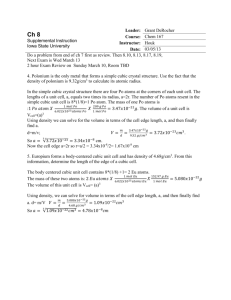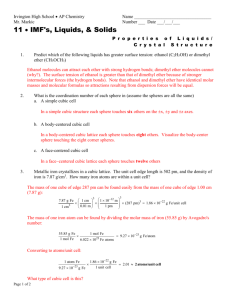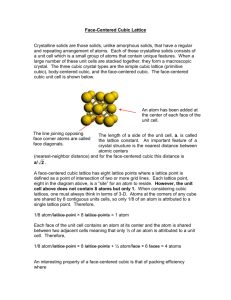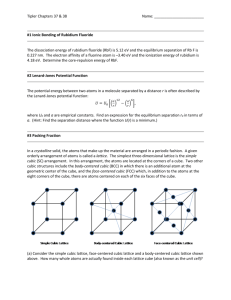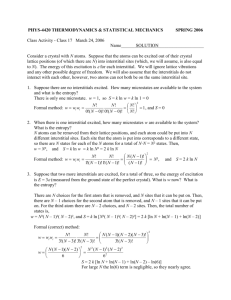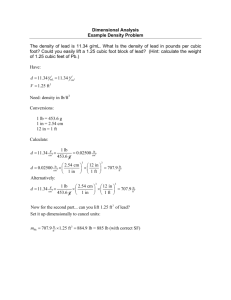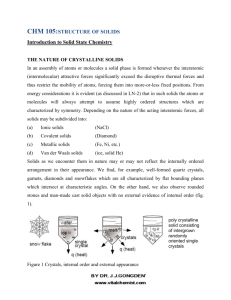bodCub
advertisement
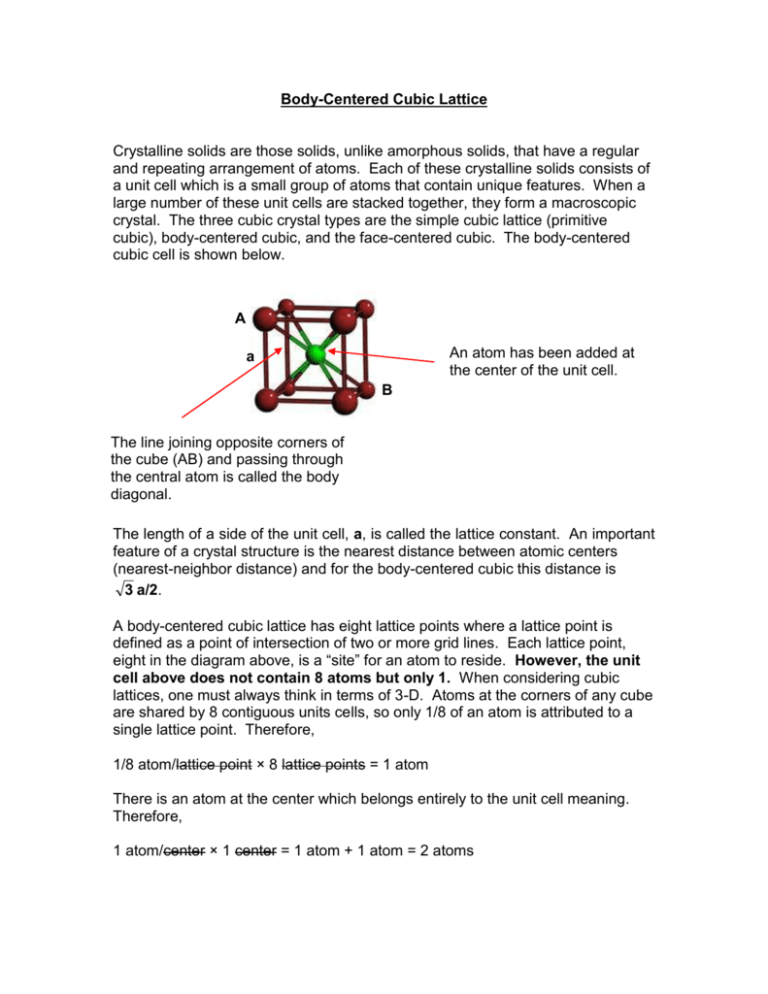
Body-Centered Cubic Lattice Crystalline solids are those solids, unlike amorphous solids, that have a regular and repeating arrangement of atoms. Each of these crystalline solids consists of a unit cell which is a small group of atoms that contain unique features. When a large number of these unit cells are stacked together, they form a macroscopic crystal. The three cubic crystal types are the simple cubic lattice (primitive cubic), body-centered cubic, and the face-centered cubic. The body-centered cubic cell is shown below. A An atom has been added at the center of the unit cell. a B The line joining opposite corners of the cube (AB) and passing through the central atom is called the body diagonal. The length of a side of the unit cell, a, is called the lattice constant. An important feature of a crystal structure is the nearest distance between atomic centers (nearest-neighbor distance) and for the body-centered cubic this distance is 3 a/2. A body-centered cubic lattice has eight lattice points where a lattice point is defined as a point of intersection of two or more grid lines. Each lattice point, eight in the diagram above, is a “site” for an atom to reside. However, the unit cell above does not contain 8 atoms but only 1. When considering cubic lattices, one must always think in terms of 3-D. Atoms at the corners of any cube are shared by 8 contiguous units cells, so only 1/8 of an atom is attributed to a single lattice point. Therefore, 1/8 atom/lattice point × 8 lattice points = 1 atom There is an atom at the center which belongs entirely to the unit cell meaning. Therefore, 1 atom/center × 1 center = 1 atom + 1 atom = 2 atoms An interesting property of a body-centered cubic is that of packing efficiency where PE = Va/Vuc × 100% and Va is the volume of the atoms occupying the interior of the cell and Vuc is the volume of the unit cell. To determine the volume of the atoms contained within the interior of the cells, first start with the diagonal which is drawn from C to B but is not shown below. A a B C The diagonal is drawn from A (upper left corner on the front face) to B (lower right hand corner on the back face) passing through central atom and is the hypotenuse of the triangle ACB. The diagonal drawn from C to B is not shown but is the base of the triangle ACB. The diagram below shows the relationship between x (the diagonal) and a which is the length and width of triangle. B x2 = a2 + a2 = 2a2 x= x C 2a a a A y a B C x= 2a Remember the relative positions of the lattice points A, B, and C and that the triangle would be rotated 45° into the plane of the page to look like ΔACB shown above. From the previous page, y2 = x2 + a2 y2 = ( 2 a)2 + a2 = 2a2 + a2 = 3a2 y= 4r = r= 3 •a 3 •a 3 •a/4 Now substituting for r in the formula for the volume of a sphere gives: Va = 4/3•π•r3•Z Va = 4/3•π•( 3 a/4)3•2 = 0.68a3 Vr = a•a•a = a3 PE = 0.68a3/a3 × 100% = 68% which applies to all body centered cubic cells. An interesting application for crystal lattices is that if you know the atomic radius of an element along with its unit cell structure, then it is possible to calculate the density of that element. Determine the density of lead given that it has a face centered cubic structure and an atomic radius of 175 pm. D = m/V m = 4 Pb atoms × 207.20 g Pb/1 mol Pb × 1 mol Pb /(6.02 x 1023 Pb atoms) m = 1.38 x 10-21 g Pb r= 2 a/4 a = 4 × 175 pm × 10-10 cm/pm / 2 = 4.95 x 10-8 cm D = (1.38 x 10-21 g)/( 4.95 x 10-8 cm)3 = 11.4 g/cm3 This is in excellent agreement with the listed density of lead, 11.35 g/cm3. Another interesting application is to determine Avogadro’s number from a unit cells data: the density of a krypton crystal is 3.18 g/cm 3, the unit cell contains 4 Kr atoms and the length of the unit cell edge is 0.559 nm. D = 3.18 g/cm3 V = a3 = (0.559 nm × 10-7 cm/nm)3 = 1.75 x 10-22 cm3 A.N. = 83.80 g Kr/1 mol Kr × 1 cm3/3.18 g Kr × 1 unit cell/(1.75 x 10-22 cm3) × 4 Kr atoms/1 unit cell = 6.03 x 1023 Kr atoms The calculated value for Avogadro’s number is in excellent agreement with 6.02 x 1023 atoms The graphic used in this tutorial was taken from the Crystal Lattice Structures Web page, http://cst-www.nrl.navy.mil/lattice/ provided by the Center for Computational Materials Science of the United States Naval Research Laboratory.
